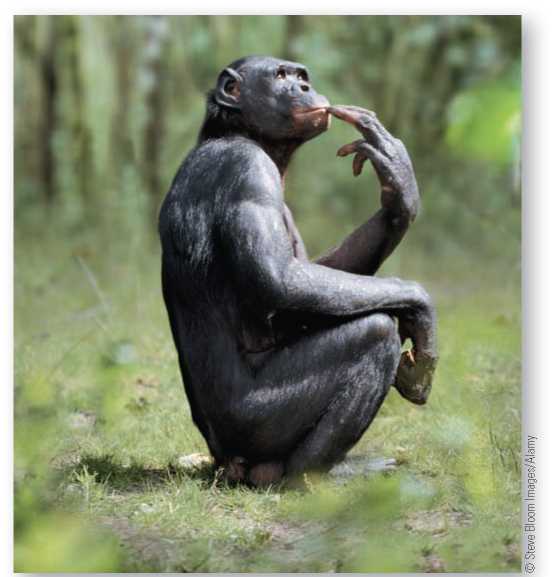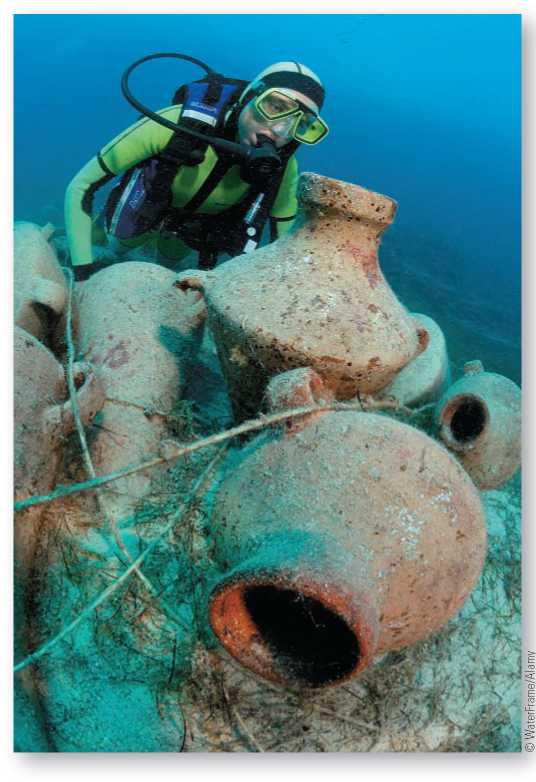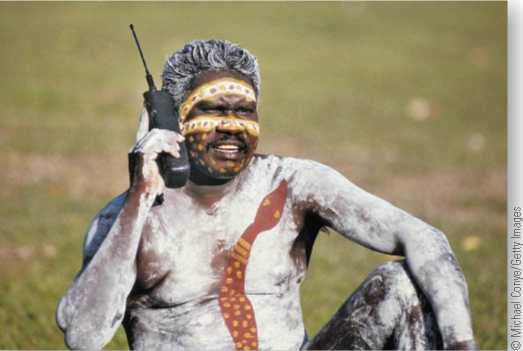Acknowledgments xxxvii About the Authors xxxix
Chapter 1 The Essence of Anthropology 2
The Development of Anthropology 4 Anthropological Perspectives 5 Anthropology and Its Fields 7 Physical Anthropology 7 Cultural Anthropology 11 Linguistic Anthropology 13 Archaeology 14
Anthropology, Science, and the Humanities 16 Fieldwork 18
Anthropology’s Comparative Method 20 Questions of Ethics 21 Anthropology and Globalization 22
Biocultural Connection: The Anthropology of Organ Transplantation 9
Anthropology Applied: Forensic Anthropology: Voices for the Dead 10
Anthropologists of Note: Franz Boas and Matilda Coxe Stevenson 17
Original Study: Fighting HIV/AIDS in Africa: Traditional Healers on the Front Line 19
Questions for Reflection 25 Suggested Readings 25
Chapter 2 Genetics and Evolution 26
The Classification of Living Things 28 The Discovery of Evolution 31 Heredity 33
The Transmission of Genes 33 Genes and Alleles 35 Cell Division 36 Polygenetic Inheritance 39
Evolution, Individuals, and Populations 41 Evolutionary Forces 42 Mutation 42 Genetic Drift 43 Gene Flow 43 Natural Selection 44 The Case of Sickle-Cell Anemia 47 Adaptation and Physical Variation 50
Biocultural Connection: The Social Impact of Genetics oN Reproduction 36
Original Study: Ninety-Eight Percent Alike: What Our Similarity to Apes Tells Us about Our Understanding of Genetics 40
Anthropology Applied: What It Means to Be a Woman: How Women Around the World Cope with Infertility 44
Questions for Reflection 51 Suggested Readings 51

Methods and Ethics in Primatology 54 Primates as Mammals 56 Primate Taxonomy 57 Primate Characteristics 60 Primate Teeth 60 Primate Sensory Organs 61 The Primate Brain 64 The Primate Skeleton 64 Living Primates 66
Lemurs and Lorises 66 Tarsiers 67
New World Monkeys 68 Old World Monkeys 69 Small and Great Apes 70 Primate Conservation 71
Original Study: Ethics of Great Ape Habituation and Conservation: The Costs and Benefits of Ecotourism 55
Biocultural Connection: Why Red Is Such a Potent Color 63
Anthropology Applied: The Congo Heartland Project 74
Questions for Reflection 75 Suggested Readings 75
Primates as Models for Human Evolution 78 Primate Social Organization 79 Home Range 80 Social Hierarchy 81 Individual Interaction and Bonding 83 Sexual Behavior 84 Reproduction and Care of Young 88 Communication and Learning 89 Use of Objects as Tools 93 Hunting 94
Anthropologists of Note: Jane Goodall and Kinji Imanishi 81
Original Study: Reconciliation and Its Cultural Modification in Primates 82
Biocultural Connection: Disturbing Behaviors of the Orangutan 86
Questions for Reflection 96 Suggested Readings 96
Chapter 5 Field Methods in Archaeology and Paleoanthropology 98
Recovering Cultural and Biological Remains 100 The Nature of Fossils 101 Burial of the Dead 103 Searching for Artifacts and Fossils 105 Site Identification 105 Archaeological Excavation 107 Fossil Excavation 109
State of Preservation of Archaeological and Fossil Evidence 110
Sorting Out the Evidence 111 Dating the Past 114
Relative Dating 115 Chronometric Dating 117 Chance and Study of the Past 119
Original Study: Whispers from the Ice 103 Anthropology Applied: Cultural Resource Management 108 Biocultural Connection: Kennewick Man 115
Questions for Reflection 120 Suggested Readings 120

Chapter 6 Macroevolution and the Early Primates 122
Macroevolution and the Process of Speciation 124 Constructing Evolutionary Relationships 127 The Nondirectedness of Macroevolution 127 Continental Drift and Geologic Time 130 Early Mammals 130 The Rise of the Primates 130 True Primates 133 Oligocene Anthropoids 134 New World Monkeys 136 Miocene Apes 136
Miocene Apes and Human Origins 140
Original Study: Melding Heart and Head 129 Biocultural Connection: Why "Ida” Inspires Navel-Gazing at Our Ancestry 135
Anthropologist of Note: Allan Wilson 139
Questions for Reflection 142 Suggested Readings 142
Chapter 7 The First Bipeds 144
The Anatomy of Bipedalism 146 Ardipithecus 148 Australopithecus 150
The Pliocene Environment and Hominin Diversity 152 Diverse Australopithecine Species 152 East Africa 152 Central Africa 158 South Africa 158 Robust Australopithecines 159 Australopithecines and the Genus Homo 162 Environment, Diet, and Origins of the Human Line 162 Humans Stand on Their Own Two Feet 163 Early Representatives of the Genus Homo 167 Lumpers or Splitters? 168 Differences Between Early Homo and Australopithecus 169
Anthropologists of Note: Louis S. B. Leakey and Mary Leakey 149
Original Study: Ankles of the Australopithecines 155 Biocultural Connection: Evolution and Human Birth 165
Questions for Reflection 170 Suggested Readings 170
Chapter 8 Early Homo and the Origins of Culture 172
The Discovery of the First Stone Toolmaker 174 Sex, Gender, and the Behavior of Early Homo 175 Hunters or Scavengers? 177 Brain Size and Diet 179 Homo erectus 180
Fossils of Homo erectus 180 Physical Characteristics of Homo erectus 181 Relationship among Homo erectus, Homo habilis, and Other Proposed Fossil Groups 183
Homo erectus from Africa 183 Homo erectus Entering Eurasia 183 Homo erectus from Indonesia 184 Homo erectus from China 184 Homo erectus from Western Europe 185 The Culture of Homo erectus 186 Acheulean Tool Tradition 186 Use of Fire 187 Hunting 188
Other Evidence of Complex Thought 188 The Question of Language 189 Archaic Homo sapiens and the Appearance of Modern-Sized Brains 190
Levalloisian Technique 191 Other Cultural Innovations 191 The Neandertals 192
Javanese, African, and Chinese Archaic Homo sapiens 194 Middle Paleolithic Culture 195
Mousterian Tool Tradition 195 The Symbolic Life of Neandertals 197 Speech and Language in the Middle Paleolithic 198 Culture, Skulls, and Modern Human Origins 200
Biocultural Connection: Sex, Gender, and Female
Paleoanthropologists 176
Original Study: Humans as Prey 178
Anthropology Applied: Stone Tools for Modern Surgeons 196
Questions for Reflection 200 Suggested Readings 200
Chapter 9 The Global Expansion of Homo sapiens and Their Technology 202
Upper Paleolithic Peoples: The First Modern Humans 204 The Human Origins Debate 205
The Multiregional Hypothesis 206 The Recent African Origins or “Eve” Hypothesis 206 Reconciling the Evidence 207 The Genetic Evidence 209 The Anatomical Evidence 209
The Cultural Evidence 210 Coexistence and Cultural Continuity 211 Race and Human Evolution 212 Upper Paleolithic Technology 213 Upper Paleolithic Art 215 Music 216 Cave or Rock Art 216 Ornamental Art 220 Gender and Art 220
Other Aspects of Upper Paleolithic Culture 220 The Spread of Upper Paleolithic Peoples 221 The Sahul 221 The Americas 222 Major Paleolithic Trends 225
Anthropologists of Note: Berhane Asfaw and Xinzhi Wu 208 Original Study: Paleolithic Paint Job 218 Biocultural Connection: Paleolithic Prescriptions for the Diseases of Civilization 226
Questions for Reflection 227 Suggested Readings 227
Chapter 10 The Neolithic Revolution: The Domestication of Plants and Animals 228
The Mesolithic Roots of Farming and Pastoralism 230 The Neolithic Revolution 231 Domestication: What Is It? 232
Evidence of Early Plant Domestication 232 Evidence of Early Animal Domestication 233 Why Humans Became Food Producers 233 The Fertile Crescent 235 Other Centers of Domestication 237 Food Production and Population Size 242 The Spread of Food Production 244 The Culture of Neolithic Settlements 244
Jericho: An Early Farming Community 244 Neolithic Material Culture 246 Neolithic Social Structure 247 Neolithic Culture in the Americas 247 The Neolithic and Human Biology 248 The Neolithic and the Idea of Progress 250
Anthropology Applied: The Real Dirt on Rainforest Fertility 240
Biocultural Connection: Breastfeeding, Fertility, and Beliefs 243
Original Study: History of Mortality and Physiological Stress 248
Questions for Reflection 251 Suggested Readings 251
Chapter 11 The Emergence of Cities and States 252
Defining Civilization 254 Tikal: A Case Study 257
Surveying and Excavating the Site 258 Evidence from the Excavation 259 Cities and Cultural Change 262 Agricultural Innovation 262 Diversification of Labor 262 Central Government 263 Social Stratification 268 The Making of States 269 Ecological Theories 269 Action Theory 270 Civilization and Its Discontents 271
Social Stratification and Disease 272 Colonialism and Disease 272 Anthropology and Cities of the Future 272
Original Study: Action Archaeology and the Community at El Pilar 260
Anthropology Applied: Tell It to the Marines: Teaching Troops about Cultural Heritage 270 Biocultural Connection: Perilous Pigs: The Introduction of Swine-Borne Disease to the Americas 274
Questions for Reflection 275 Suggested Readings 275

Chapter 12 Modern Human Diversity: Race and Racism 276
The History of Human Classification 278
Race as a Biological Concept 281
Conflation of the Biological into the Cultural Category
Of Race 282
The Social Significance of Race: Racism 284 Race and Behavior 284 Race and Intelligence 284 Studying Human Biological Diversity 288 Culture and Biological Diversity 290 Skin Color: A Case Study in Adaptation 292 Race and Human Evolution 294
Anthropologist of Note: Fatimah Jackson 280 Original Study: A Feckless Quest for the Basketball Gene 286
Biocultural Connection: Beans, Enzymes, and Adaptation to Malaria 292
Questions for Reflection 296 Suggested Readings 297
Chapter 13 Human Adaptation to a Changing World 298
Human Adaptation to Natural Environmental Stressors 301
Adaptation to High Altitude 303 Adaptation to Cold 304 Adaptation to Heat 305
Human-Made Stressors of a Changing World 305 The Development of Medical Anthropology 306
Science, Illness, and Disease 307 Evolutionary Medicine 312
Symptoms as Defense Mechanisms 312 Evolution and Infectious Disease 313 The Political Ecology of Disease 314 Prion Diseases 314 Medical Pluralism 315
Globalization, Health, and Structural Violence 315 Population Size and Health 316 Poverty and Health 317 Environmental Impact and Health 317 The Future of Homo sapiens 320
Anthropologist of Note: Peter Ellison 302
Original Study: Dancing Skeletons: Life and Death in West
Africa 310
Biocultural Connection: Picturing Pesticides 319
Questions for Reflection 321 Suggested Readings 321
Glossary 322 Bibliography 327 Credits 344 Index 346
This page intentionally left blank




 World History
World History









